MVNE, MVNA and MVNO differences explained in a simple way
The differences between MVNE, MVNA and MVNO are explained in a simple way. In essence they all need a Mobile Network Operator (MNO).
The telecommunications industry uses many terms which can be confusing. The industry is also evolving at an unprecedented rate, with thousands of new business models and use cases emerging every year. There are also different types of MVNOs for more information see here.
We will go over the following:
- Introduction about Telecom Operators
- Which types of Telecom operators are there?
- The differences between MVNE, MVNA and the types of MVNOs.
- What is the difference between an MNO and MVNO?
- What is the difference between MVNA and MVNE?
- What is the difference between MVNE and MVNO?
- What is the difference between thick MVNO and full MVNO?
- What is the difference between full MVNO and light MVNO?
- What is the difference between light MVNO and thin MVNO?
- Overall
- Frequently Asked Questions (FAQs)
What are Telecom Operators?
Telecom operators, also known as telecommunications service providers, are companies that provide a range of communication services to customers. Services such as fixed and/or Mobile telephone, Internet, and television. These services are typically provided over a (mobile) core network of infrastructure, including telephone lines, fiber optic cables, and satellite systems.
Which different Telecom operators are there?
There are several types of telecom operators that can act as a network provider for MVNE, MVNA, MVNOs, including:
- Incumbent operators: These are the traditional providers of fixed or mobile telecom services, often with a long history in the industry and a large customer base. They may be state-owned or privately owned.
- Alternative operators: These are newer entrants into the telecom industry, often offering more specialized or innovative services. They may be smaller in size compared to incumbent operators.
- Mobile network operators (MNOs): These operators own and operate their own mobile networks, providing voice and data services to customers. They can also lease capacity to MVNEs or MVNOs.
- Internet service providers (ISPs): These operators provide internet access to customers over a variety of technologies, including broadband, Fiber, DSL, and dial-up.
- Cable television operators: These operators provide television programming to customers via a network of coaxial cables.
Overall, MVNOs rely on MNOs and/or MVNEs to provide the necessary infrastructure and support for their operations. They also rely on the relationships between these different types of telecom operators are an important aspect of the telecom industry.
What are the differences between MVNE, MVNA and the types of MVNOs?
- What is the difference between an MNO and MVNO?
- What is the difference between MVNA and MVNE?
- What is the difference between MVNE and MVNO?
- What is the difference between thick MVNO and full MVNO?
- What is the difference between full MVNO and light MVNO?
- What is the difference between light MVNO and thin MVNO?
What is the difference between an MNO and MVNO?

The difference between an MNO and MVNO
The critical difference is that MNOs own their own wireless core network infrastructure (antennas) including a network (3G, 4G, 5G, 6G) license and MVNOs do not. To facilitate mobile services to their subscribers, MVNOs must purchase access to radio network infrastructure either directly from MNOs, or indirectly from Mobile Virtual Network Enablers (MVNE). Next to this they need to arrange a wholesale agreement, this can be directly with the MNO or from a Mobile Virtual Network Aggregators (MVNA).
It should also be noted that MVNOs are increasingly popular among consumers since they tend to offer more flexibility than MNOs. Indeed, because MNOs tend to have much larger customer bases, their services need to appeal to broader parts of the market. This leads to generic services, rigid pricing, one-size-fits-all data plans, and uninspiring branding.
In contrast, the pricing and branding independence enjoyed by MVNOs enables them to home in on ultra-specific customer segments, like low-income consumers, students, the older people — basically anyone that does not fall neatly into the generic plans offered by MNOs.
Along the same lines, MVNOs enable businesses to diversify or enhance existing offerings. For example, many Internet Service Providers (ISP) have begun offering mobile services alongside ADSL to retain current customers, attract new customers, and bolster revenue.
What is the difference between MVNA and MVNE?
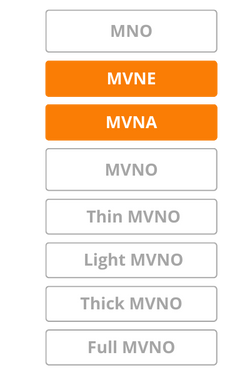
The difference between MVNA and MVNE
MVNA stands for Mobile Virtual Network Aggregator, while MVNE stands for Mobile Virtual Network Enabler. Both companies offer mobile telecommunications services without owning their own core network & radio network / wireless towers infrastructure or cables.
An MVNA is a company that provides mobile network services by aggregating the capacity and sometimes even the coverage of Multiple Network Operators (MNO). An MVNA does not have its own wireless infrastructure. It relies on the infrastructure of other mobile network operators to provide a service to its customers. An MVNA acts as a middleman between network operators and customers, offering a range of mobile services such as voice, text, and data. This means they will have a wholesale agreement with one or more MNOs and resell this to MVNOs.
An MVNE, on the other hand, is a company that provides mobile network services by leasing capacity and coverage from other mobile network operators (MNO). Like an MVNA, an MVNE does not own its own wireless infrastructure. They are responsible for managing and operating its own virtual network. An MVNE can offer a range of mobile services to its customers, including voice, text, and data. An MVNE can also be the MVNA which can give a price advantage since they might get volume discount, but if the MVNE does not have a wholesale agreement it means you need to take care of this.
In summary
The main difference between an MVNA and an MVNE is that an MVNA aggregates the capacity and coverage of multiple network operators. While an MVNE leases capacity and coverage from other network operators and operates its own virtual network. It can be an advantage to make use of an MVNA. Since they mostly get better wholesale prices because they can combine the volume of all MVNOs. Of course, keep in mind that the MVNA will take some of the margin of this.
What is the difference between MVNE and MVNO?
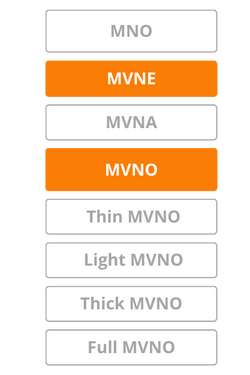
The difference between MVNE and MVNO
MVNE stands for Mobile Virtual Network Enabler, while MVNO stands for Mobile Virtual Network Operator. Both companies offer mobile telecommunications services without owning their own physical infrastructure, such as wireless towers or cables.
An MVNE is a company that provides mobile network services by leasing capacity and coverage from other mobile network operators. As mentioned MVNE does not have its own wireless infrastructure, but it is responsible for managing and operating its own virtual network. An MVNE can offer a range of mobile services to its customers the MVNO(s), including voice, text, and data. The MVNE will usually host multiple MVNOs and can be seen as B2B. This means they do not offer services to consumers.
An MVNO (sometimes also called VNO), is a company that provides mobile network services by leasing capacity and coverage from a mobile network operator and reselling those services to its own customers. Like an MVNE, an MVNO does not own its own wireless infrastructure. However, it relies on the infrastructure of another network operator to provide service to its customers. An MVNO typically makes use of an MVNE or MVNA solution provider. It offers a range of mobile services, including voice, text, and data to consumers (B2C).
In summary
The main difference between an MVNE and an MVNO is that an MVNE is responsible for managing and operating its own virtual network. While an MVNO makes use of another network operator or an MVNE to provide service and simply resells those services to its own customers. Small MVNOs typically make use of an MVNE to lower the setup/startup costs.
What is the difference between Thick MVNO and Full MVNO?
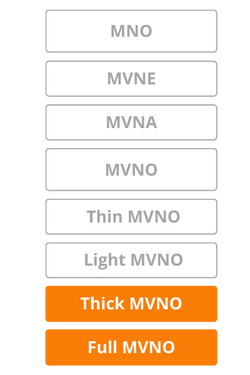
The difference between Thick MVNO and Full MVNO
A thick MVNO is a type of Mobile Virtual Network Operator (MVNO) that has less control over its own operations compared to a full MVNO. This is because a thick MVNO will have some core network elements, but not all. Having some core network elements will increase their control over the products and services it offers to customers. A thick MVNO typically has its own customer care, billing, other back-office systems, and sales/marketing teams. Both have their own Business Support System (BSS) and Operational Support Systems (OSS).
A full MVNO is a type of MVNO that has complete control over its own operations and customer experience. A full MVNO has ALL the core network elements and acts as a standalone wireless carrier, like a traditional mobile network operator (MNO). The core network elements such as an HRL, GGSN, PGW, SMS-C, SCP are all there. While a thick MVNO will have some of these elements. A full MVNO is responsible for all aspects of its business, including marketing, sales, customer service, and network maintenance.
In summary
The main difference between a thick MVNO and a full MVNO is the degree of control of the core network elements and independence each has over its operations. A thick MVNO relies a bit more on a traditional MNO for some infrastructure support. While a full MVNO operates as a standalone carrier with its own infrastructure. Keep in mind that core network elements are expensive and the implementation costs and the costs to maintain them are high.
What is the difference between Full MVNO and Light MVNO?
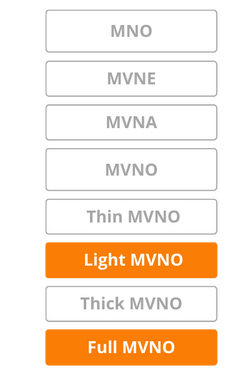
The difference between Full MVNO and Light MVNO
A full Mobile Virtual Network Operator (MVNO) is a company that provides mobile network services by leasing capacity and coverage from a mobile network operator and reselling those services to its own customers. A full MVNO is sometimes also called Enhanced Service Provider. A full MVNO typically offers a range of mobile services, including voice, text, and data. The full MVNO can set its own prices and create its own plans for its customers. A full MVNO typically also has all the core network elements. This enables the full MVNO to have more control over their services. A full MVNO is responsible for marketing, sales, and customer service for its own brand. Both have their own Business Support System (BSS) and Operational Support Systems (OSS).
A light MVNO is a company that operates in a similar way to a full MVNO, but with some key differences. A light MVNO, also called Service Provider, typically only offers a limited range of mobile services, such as voice, data, or text, and can set its own prices/plans. A light MVNO does not have any core network elements. A light MVNO does its own marketing, sales, and customer service. However, it has limited options/flexibility compared to a full MVNO such as charging different Data rates. For example, depending on the Data type (e.g. free Facebook) free usage). Instead, they rely on the mobile network operator to handle these functions.
In summary
The main difference between a full/thick MVNO and a light MVNO is the extent of control and responsibility that each type of MVNO has over its mobile network services. A full/thick MVNO has all control and responsibility. While a light MVNO has less control and responsibility. A light MVNO is easier and less expensive to setup. However, the margins (ARPU) per subscriber will be lower because they make more use of the MNO services.
What is the difference between Light MVNO and Thin MVNO?
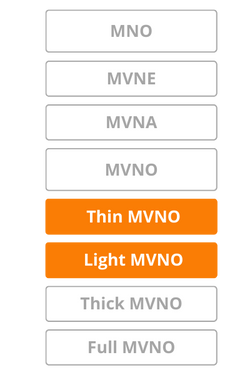
The difference between Light MVNO and Thin MVNO
A light MVNO is a type of Mobile Virtual Network Operator (MVNO) that has a limited range of products and services compared to a traditional mobile network operator (MNO) or a full/thick MVNO (see above). Light MVNO mostly focuses on specific segments of the market. Such as prepaid customers or specific demographics, communities and so on and offer a limited/specific selection of plans or features.
A thin MVNO, on the other hand, is a type of MVNO that has very little control over its own operations and relies heavily on the infrastructure and support of a traditional MNO. A thin MVNO may have limited or no control over its own billing, bundles, and other back-office systems. They will simply rebrand and resell the same products and services as the MNO to customers under their own brand. In some case the thin MVNO also resells for a light/thick/full MVNO. Only the Light MVNO has it’s own Business Support System (BSS) and Operational Support Systems (OSS). The thin MVNO make use of the supplier environment under his own (branded) login.
In summary
The main difference between a light MVNO and a thin MVNO is the degree of control and independence each has over its operations and product offerings. A light MVNO has usually a wider ranger of products and services and has more control over its own operations compared to a thin MVNO which is simply a reseller with normally its own customer care.
There is also a Skinny MVNO, which usually is described as Branded Reseller. They just resell the same offering as an MNO or MVNO by using their offering but with their own Brand name.
Overall
The MVNE/A can be set up as light/thick/full MVNE like an MVNO, thus offering less or more features. The full MVNO is the most expansive setup but will give the best flexibility and control for the different MVNO types. It can be wise to start as a thin, light MVNO and expand when your customer/subscriber base grows.
This is of course all depending on your business plan, marketing plan, financial plan, etc. See also Different types of MVNOs
What is the difference between an MNO and an MVNO?
An MNO (Mobile Network Operator) owns and operates its own mobile network infrastructure and radio spectrum. An MVNO (Mobile Virtual Network Operator) does not own network infrastructure and instead leases network capacity from an MNO, either directly or through an MVNE or MVNA, to sell mobile services under its own brand.
What does an MVNE do compared to an MVNO?
An MVNE (Mobile Virtual Network Enabler) provides the technical and operational backbone required to run an MVNO, including OSS/BSS platforms, billing, SIM or eSIM provisioning, customer management, and network integration. Unlike an MVNO, an MVNE does not market services directly to consumers.
How is an MVNA different from an MVNE?
A Mobile Virtual Network Aggregator (MVNA) aggregates wholesale network capacity from one or more MNOs and resells it to multiple MVNOs. An MVNE primarily delivers technical enablement and operational systems, while an MVNA may combine commercial aggregation with selected enablement services.
How does an MVNE differ from an MVNO?
An MVNE operates behind the scenes, enabling mobile brands with platforms and infrastructure. An MVNO is the customer-facing entity responsible for branding, pricing, marketing, and customer relationships, while relying on an MVNE or MVNA for technical execution.
What is the difference between a Thick MVNO and a Full MVNO?
A Thick MVNO operates some core systems and network components but still depends on partners for certain elements. A Full MVNO has extensive control over its own core network, OSS/BSS, and service logic, operating much like an independent mobile operator without owning radio spectrum.
How does a Full MVNO differ from a Light MVNO?
A Full MVNO controls most network and operational components, enabling maximum flexibility and scalability. A Light MVNO focuses mainly on branding, sales, and customer care while relying heavily on partners for network services, allowing for faster and lower-cost market entry.
What is the difference between a Light MVNO and a Thin MVNO?
A Light MVNO typically manages customer-facing operations and selected systems, while a Thin MVNO has minimal operational control and primarily resells mobile services using a partner’s full infrastructure and processes.








